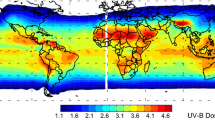Summary
The diffuse sky radiation component in the ultraviolet wavelengths is often at least 50% of the global irradiance under clear skies, and is the dominant component of ultraviolet global radiation under translucent overcast skies. The distribution of sky radiance was measured in a rural area and modeled for wavelength bands of ultraviolet-B (UVB, 280–320 nm) and ultraviolet-A (UVA, 320–400 nm). Sky radiance measurements were made during the summer of 1993 over a wide range of solar zenith angles using radiance sensors mounted on a hand-operated hemispherical rotation mount. UVB irradiance measurements were also made during each scan. Since the ratio of measured irradiance under overcast skies and that predicted for clear skies was not correlated with cloud base height, opaque cloud fraction, or solar zenith angle, it was concluded that the scattering from the clouds dominated the global irradiance, and this scattering was relatively unaffected by the scattering off opaque clouds in the translucent atmosphere.
Analysis of the translucent overcast sky UVA and UVB radiance measurements using a semi-empirical distribution model showed that the spectral influences on multiple scattering, single scattering, and horizon brightening components of the distributions agreed with basic atmospheric radiation theory. The best model used solar zenith, the sky zenith, and the scattering angle with resultant coefficient of determination values of 0.62 and 0.25 for the UVA and UVB respectively. The developed equations can be applied directly to the diffuse sky irradiance on the horizontal to provide radiance distributions for the sky.
Similar content being viewed by others
References
ASTM., 1980: Standard practice for dealing with outlying observations. American Standards of Testing and Materials.Standard E1 78–80.
Beaglehole, D., Carter, G. G., 1992: Antarctic skies. 2. Characterization of intensity and polarization of skylight in a high albedo environment.J. Geophys. Res. 97, 2597–2600.
Blumthaler, M., Ambach, W., 1988: Solar UVB-albedo of various surfaces.Photochem Photobiol. 48, 85–88.
Blumthaler, M., Ambach, W., Salzgeber, M., 1994: Effects of cloudiness on global and diffuse UV irradiance in a high-mountain area.Theor. Appl. Climatol. 50, 23–30.
Brunger, A. P., Hooper, F. C., 1991: Measured short-wave sky radiance in an urban atmosphere.Solar Energy 47, 137–142.
Brunger, A. P., Hooper, F. C., 1993: Anisotropic sky radiance model based on narrow field of view measurements of short-wave radiance.Solar Energy 51, 53–64.
Coombes, C. A., Harrison, A.W., 1988: Angular distribution of overcast sky short wavelength radiance.Solar Energy 40, 161–166.
Deepak, A., 1977: Inversion of solar aureole measurements for determining aerosol characteristics. In: Deepak, A. (ed.)Inversion Methods in Atmospheric Remote Sounding. New York: Academic Press, pp. 265–291.
Draper, N., Smith, H., 1981:Applied Regression Analysis, 2nd edn. New York: Wiley 709p.
Feister, U., Grewe, R., 1995: Spectral albedo measurements in the UV and visible region over different types of surfaces.Photochem. Photobiol. 62, 736–744.
Ferguson, T. S., 1961: Rules for rejection of outliers.Revue Inst. de Stat. 3, 29–43.
Fritz, S., 1955: Illuminance and luminance under overcast skies.J. Opt. Soc. Amer. 45, 820–825.
Garrison, L. M., Murray, L. E., Doda, D. D., Green, A. E. S., 1978: Diffuse-direct ultraviolet ratios with a compact double monochronometer.Applied Optics 17, 827–836.
Grant, R. H., 1996: Characterization of UVA and UVB irradiance sensor systems, pp. 169–172 inProceedings of the 22nd Conf. on Agricultural and Forest Meteorology, American Meteorological Society.
Grant, R. H., Heisler, G. M., Gao, W., 1996a: Clear sky radiance distributions in ultraviolet wavelength bands.Theor. Appl. Climatology. (in press).
Grant, R. H., Heisler, G. M., Gao, W., 1996b: Photosynthetically-active radiation: sky radiance distributions under clear and overcast conditions.Agric. and Forest Meteorol. (in press).
Green, A. E. S., Cross, K. R., Smith, L. A., 1980: Improved analytic characterization of ultraviolet skylight.Photochem. Photobiol. 31, 59–65.
Green, A. E. S., Swada, T., Shettle, E. P., 1974: The middle ultraviolet reaching the ground.Photochem. Photobiol. 19, 251–259.
Iqbal, M., 1983:An Introduction to Solar Radiation. Toronto, Canada: Academic Press, 390 pp.
Kittler, R., Valko, P., 1993: Radiance distribution on densely overcast skies: comparison with CIE luminance distribution.Solar Energy 51, 349–355.
Madronich, S., DeGruijl, F. R., 1994: Stratospheric ozone depletion between 1979 and 1992: implications for biologically active ultraviolet-B radiation and non-melanoma skin cancer incidence.Photochem. Photobiol. 59, 541–546.
Nack, M. L., Green, A. E. S., 1974: Influence of clouds, haze, and smog on the middle ultraviolet reaching the ground.Appl. Optics 13, 2405–2415.
Nunez, M., Forgan, B., Roy, C., 1994: Estimating ultraviolet radiation at the earth's surface.Int. J. Biometeorol. 38, 5–17.
Powkrowski, G. I., 1929: Über einen scheinbaren Mie-Effect und seine mögliche Rolle in der Atmosphärenoptik.Zeitschrift für Physik 53, 67–71.
Rosen, M. A., 1992: Investigation of the validity of the TDRC model for the distribution of diffuse sky radiance.Solar Energy 48, 123–131.
Schippnick, P. F., Green, A. E. S., 1982: Analytical characterization of spectral irradiance in the middle ultraviolet.Photochem. Photobiol. 35, 89–101.
Spinhirne, J. D., Green, A. E. S., 1978: Calculation of relative influence of cloud layers on received ultraviolet and integrated solar radiation.Atmos. Environ. 12, 2449–2454.
Stamnes, K., Slusser, J., Bowen, M., 1991: Derivation of total ozone abundance and cloud effects from spectral irradiance measurements.Appl. Optics 30, 4418–4426.
Steven, M. D., Unsworth, M. H., 1980: The angular distribution and interception of diffuse solar radiation below overcast skies.Quart. J. Roy. Meteor. Soc. 106, 57–61.
Tselioudis, G., Rossow, W. B., Rind, D., 1992: Global patterns of cloud optical thickness variation with temperature.J. Climate 5, 1484–1495.
Author information
Authors and Affiliations
Additional information
With 6 Figures
Rights and permissions
About this article
Cite this article
Grant, R.H., Heisler, G.M. & Gao, W. Ultraviolet sky radiance distributions of translucent overcast skies. Theor Appl Climatol 58, 129–139 (1997). https://doi.org/10.1007/BF00865013
Received:
Revised:
Issue Date:
DOI: https://doi.org/10.1007/BF00865013



